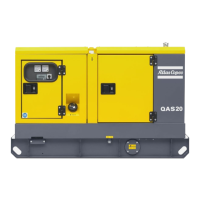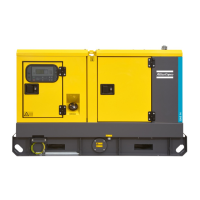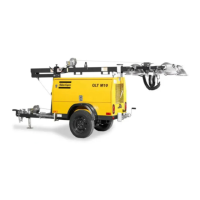- 10 -
0.3 SAFETY DURING TRANSPORT AND
INSTALLATION
To lift a unit, all loose or pivoting parts, e.g. doors and towbar, shall first be
securely fastened.
Do not attach cables, chains or ropes directly to the lifting eye; apply a
crane hook or lifting shackle meeting local safety regulations. Never allow
sharp bends in lifting cables, chains or ropes.
Helicopter lifting is not allowed.
It is strictly forbidden to dwell or stay in the risk zone under a lifted load.
Never lift the unit over people or residential areas. Lifting acceleration and
retardation shall be kept within safe limits.
1 Before towing the unit:
- check the towbar, the brake system and the towing eye. Also check
the coupling of the towing vehicle,
- check the towing and brake capability of the towing vehicle,
- check that the towbar, jockey wheel or stand leg is safely locked in
the raised position,
- ascertain that the towing eye can swivel freely on the hook,
- check that the wheels are secure and that the tyres are in good
condition and inflated correctly,
- connect the signalisation cable, check all lights and connect the
pneumatic brake couplers,
- attach the safety break-away cable or safety chain to the towing
vehicle,
- remove wheel chocks, if applied, and disengage the parking brake.
2 To tow a unit use a towing vehicle of ample capacity. Refer to the
documentation of the towing vehicle.
3 If the unit is to be backed up by the towing vehicle, disengage the
overrun brake mechanism (if it is not an automatic mechanism).
4 Never exceed the maximum towing speed of the unit (mind the local
regulations).
5 Place the unit on level ground and apply the parking brake before
disconnecting the unit from the towing vehicle. Unclip the safety
break-away cable or safety chain. If the unit has no parking brake or
jockey wheel, immobilize the unit by placing chocks in front of and/or
behind the wheels. When the towbar can be positioned vertically, the
locking device must be applied and kept in good order.
6 To lift heavy parts, a hoist of ample capacity, tested and approved
according to local safety regulations, shall be used.
7 Lifting hooks, eyes, shackles, etc., shall never be bent and shall only
have stress in line with their design load axis. The capacity of a lifting
device diminishes when the lifting force is applied at an angle to its
load axis.
8 For maximum safety and efficiency of the lifting apparatus all lifting
members shall be applied as near to perpendicular as possible. If
required, a lifting beam shall be applied between hoist and load.
9 Never leave a load hanging on a hoist.
10 A hoist has to be installed in such a way that the object will be lifted
perpendicular. If that is not possible, the necessary precautions must be
taken to prevent load-swinging, e.g. by using two hoists, each at
approximately the same angle not exceeding 30° from the vertical.
11 Locate the unit away from walls. Take all precautions to ensure that
hot air exhausted from the engine and driven machine cooling systems
cannot be recirculated. If such hot air is taken in by the engine or
driven machine cooling fan, this may cause overheating of the unit; if
taken in for combustion, the engine power will be reduced.
12 Generators shall be stalled on an even, solid floor, in a clean location
with sufficient ventilation. If the floor is not level or can vary in
inclination, consult Atlas Copco.
13 The electrical connections shall correspond to local codes. The
machines shall be earthed and protected against short circuits by fuses
or circuit breakers.
14 Never connect the generator outlets to an installation which is also
connected to a public mains.
15 Before connecting a load, switch off the corresponding circuit breaker,
and check whether frequency, voltage, current and power factor
comply with the ratings of the generator.
0.4 SAFETY DURING USE AND OPERATION
1 When the unit has to operate in a fire-hazardous environment, each
engine exhaust has to be provided with a spark arrestor to trap
incendiary sparks.
2 The exhaust contains carbon monoxide which is a lethal gas. When the
unit is used in a confined space, conduct the engine exhaust to the
outside atmosphere by a pipe of sufficient diameter; do this in such a
way that no extra back pressure is created for the engine. If necessary,
install an extractor. Observe any existing local regulations. Make sure
that the unit has sufficient air intake for operation. If necessary, install
extra air intake ducts.
3 When operating in a dust-laden atmosphere, place the unit so that dust
is not carried towards it by the wind. Operation in clean surroundings
considerably extends the intervals for cleaning the air intake filters and
the cores of the coolers.
4 Never remove a filler cap of the cooling water system of a hot engine.
Wait until the engine has sufficiently cooled down.
5 Never refill fuel while the unit is running, unless otherwise stated in
the Atlas Copco Instruction Book (AIB). Keep fuel away from hot
parts such as air outlet pipes or the engine exhaust. Do not smoke
when fuelling. When fuelling from an automatic pump, an earthing
cable should be connected to the unit to discharge static electricity.
Never spill nor leave oil, fuel, coolant or cleansing agent in or around
the unit.
6 All doors shall be shut during operation so as not to disturb the cooling
air flow inside the bodywork and/or render the silencing less effective.
A door should be kept open for a short period only e.g. for inspection
or adjustment.
7 Periodically carry out maintenance works according to the
maintenance schedule.
8 Stationary housing guards are provided on all rotating or reciprocating
parts not otherwise protected and which may be hazardous to
personnel. Machinery shall never be put into operation, when such
guards have been removed, before the guards are securely reinstalled.
9 Noise, even at reasonable levels, can cause irritation and disturbance
which, over a long period of time, may cause severe injuries to the
nervous system of human beings.
When the sound pressure level, at any point where personnel normally
has to attend, is:
below 70 dB(A): no action needs to be taken,
above 70 dB(A): noise-protective devices should be provided for
people continuously being present in the room,
below 85 dB(A): no action needs to be taken for occasional visitors
staying a limited time only,
above 85 dB(A): room to be classified as a noise-hazardous area and
an obvious warning shall be placed permanently at
each entrance to alert people entering the room, for
even relatively short times, about the need to wear
ear protectors,
above 95 dB(A): the warning(s) at the entrance(s) shall be
completed with the recommendation that also
occasional visitors shall wear ear protectors,
above 105 dB(A): special ear protectors that are adequate for this
noise level and the spectral composition of the
noise shall be provided and a special warning to
that effect shall be placed at each entrance.
10 Insulation or safety guards of parts the temperature of which can be in
excess of 80 °C (175 °F) and which may be accidentally touched by
personnel shall not be removed before the parts have cooled to room
temperature.
11 Never operate the unit in surroundings where there is a possibility of
taking in flammable or toxic fumes.
12 If the working process produces fumes, dust or vibration hazards, etc.,
take the necessary steps to eliminate the risk of personnel injury.

